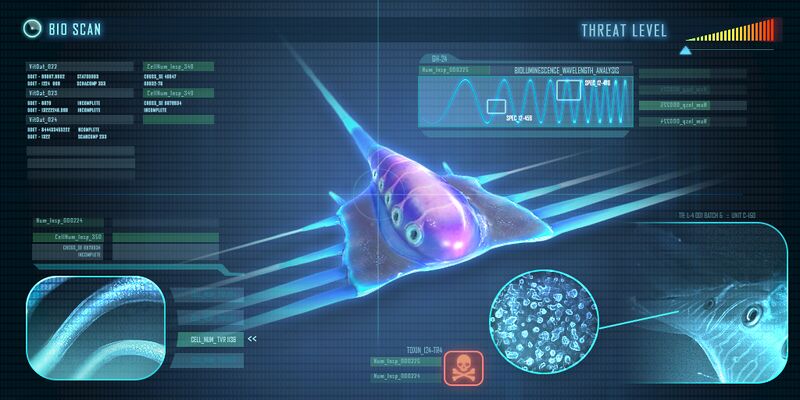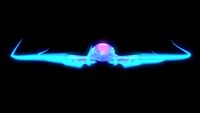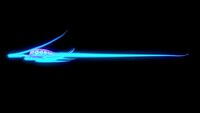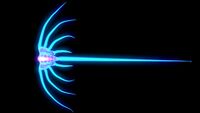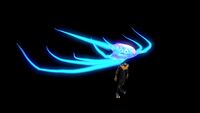Jellyray: Difference between revisions
No edit summary Tag: rte-source |
No edit summary Tag: rte-source |
||
| Line 10: | Line 10: | ||
The '''Jellyray''' is a type of passive [[Life Forms|life form]], belonging to the [[fauna]] category, that can be found roaming in the [[Mushroom Forest]] or the [[Deep Grand Reef]] biomes. |
The '''Jellyray''' is a type of passive [[Life Forms|life form]], belonging to the [[fauna]] category, that can be found roaming in the [[Mushroom Forest]] or the [[Deep Grand Reef]] biomes. |
||
== |
==Appearance== |
||
The '''Jellyray''' possesses a translucent, constantly [[Bioluminescence|glowing]] body. It has a long, thin tail and six, smaller undulating tentacles protruding from each side of its body. The main body glows a violet hue, with bright pink patterns on its back, the rest of the creature glows a light blue colour. |
The '''Jellyray''' possesses a translucent, constantly [[Bioluminescence|glowing]] body. It has a long, thin tail and six, smaller undulating tentacles protruding from each side of its body. The main body glows a violet hue, with bright pink patterns on its back, the rest of the creature glows a light blue colour. |
||
| Line 37: | Line 37: | ||
* Ward away predators |
* Ward away predators |
||
* Identify the organism to others of its kind |
* Identify the organism to others of its kind |
||
| Line 47: | Line 48: | ||
|} |
|} |
||
== |
==Gallery== |
||
<tabber> |
|||
In Game Screenshots= |
|||
<gallery position="left" widths="200" spacing="small" captionalign="left"> |
<gallery position="left" widths="200" spacing="small" captionalign="left"> |
||
JellyrayB.jpg|Front view |
JellyrayB.jpg|Front view |
||
| Line 57: | Line 56: | ||
Jellyray6.jpg|Size comparison with the player |
Jellyray6.jpg|Size comparison with the player |
||
</gallery> |
</gallery> |
||
</tabber> |
|||
==Trivia== |
==Trivia== |
||
Revision as of 08:12, 20 March 2017
Template:Class 2 Fauna The Jellyray is a type of passive life form, belonging to the fauna category, that can be found roaming in the Mushroom Forest or the Deep Grand Reef biomes.
Appearance
The Jellyray possesses a translucent, constantly glowing body. It has a long, thin tail and six, smaller undulating tentacles protruding from each side of its body. The main body glows a violet hue, with bright pink patterns on its back, the rest of the creature glows a light blue colour.
The Jellyray has six circles of various sizes on each side of its torso. These circles could possibly be its eyes, however it is unknown what their purpose is.
Behavior
Jellyrays aimlessly glide around, dragging their tentacles behind them when doing so and emitting high pitched cries.
They are curious about light, and can usually be seen investigating any nearby light sources.
Energy Value
Data Bank Entry
|
Shares some evolutionary traits with the Rabbit Ray, including highly poisonous flesh. This species has adapted to low-light environments with a translucent, luminescent body. This may help to:
Smaller creatures have been seen swimming in the jellyray's wake to take advantage of the light source for their own ends.
|
Gallery
Trivia
- The sounds of the Jellyray were created from wolf howls[1]
- The Jellyray has one subspecies, the Ghostray which also has a subspecies, the Crimson Ray, and is related to the Rabbit Ray. This is confirmed by the PDA datalogs, which states that they all share a common ancestor.
- Jellyrays possess highly poisonous flesh and as such, they have few natural predators - a trait shared with the other ray-species and probably developed by their common ancestor.
- Jellyrays are bottom-dwellers, preferring to glide over the seabed. This suggests they're detritivores - surviving from organic waste that settles down on the seabed. This is further supported by the databank entry of the
References
Lua error in package.lua at line 80: module 'Dev:Navbox' not found.





